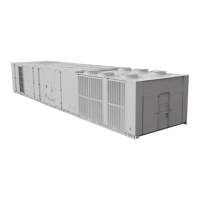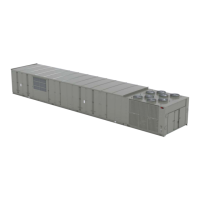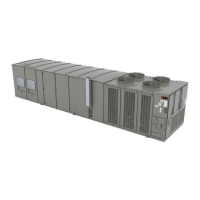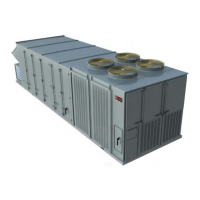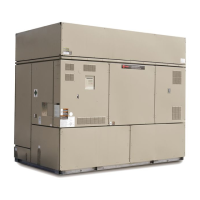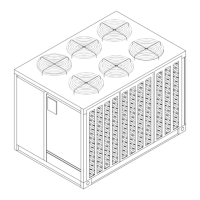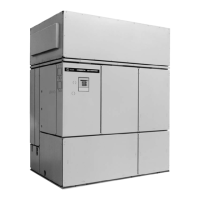Maintenance
RT-SVX36K-EN 179
Adjustment” section for belt replacement and
adjustments.
• Check the condition of the gasket around the control
panel doors.These gaskets must fit correctly and be in
good condition to prevent water leakage.
• Verify that all wire terminal connections are tight.
• Remove any corrosion present on the exterior surfaces
of the unit and repaint these areas.
• Generally inspect the unit for unusual conditions (e.g.,
loose access panels, leaking piping connections, etc.)
• Make sure that all retaining screws are reinstalled in
the unit access panels once these checks are complete.
• With the unit running, check and record the:
– ambient temperature;
– compressor oil level (each circuit);
– compressor suction and discharge pressures (each
circuit);
– superheat and subcooling (each circuit);
Record this data on an “operator’s maintenance log”
like the one shown in Table 80, p. 183. If the operating
pressures indicate a refrigerant shortage, measure the
system superheat and system subcooling. For
guidelines, refer to “Charging by Subcooling”.
Important: Do NOT release refrigerant to the
atmosphere! If adding or removing
refrigerant is required, the service
technician must comply with all federal,
state and local laws. Refer to general service
bulletin MSCU-SB-1 (latest edition).
Heating Season
Before completing the following checks, turn the unit OFF
and lock the main power disconnect switch open.
• Inspect the unit’s air filters. If necessary, clean or
replace them.
• Check supply fan motor bearings; repair or replace the
motor as necessary. If the unit model number indicates
that the motor has an internal shaft ground, replace
with the same motor type.
• Lubricate the supply fan shaft bearings with a lithium
based grease. Refer to Table 72, p. 170 for
recommended greases.
Note: The bearings are manufactured using a special
synthetic lithium based grease designed for long
life and minimum lube intervals.Too much
lubrication in a bearing can be just as harmful as
not enough.
• Use a hand grease gun to lubricate the bearings; add
grease until a light bead appears all around the seal. Do
not over lubricate!
• After greasing the bearings, check the setscrews to
ensure that the shaft is held securely. Make sure that all
bearing braces are tight.
• Inspect both the main unit control panel and heat
section control box for loose electrical components
and terminal connections, as well as damaged wire
insulation. Make any necessary repairs.
• Gas Heat Units only - Check the heat exchanger for any
corrosion, cracks, or holes.
• Check the combustion air blower for dirt. Clean as
necessary.
Note: Typically, it is not necessary to clean the gas
furnace. However, if cleaning does become
necessary, remove the burner inspection plate
from the rear of the heat exchanger to access the
drum. Be sure to replace the existing gaskets with
new ones before reinstalling the inspection plate.
• Open the main gas valve and apply power to the unit
heating section; then initiate a “Heat” test using the
start-up procedure described in “Gas Furnace Start-
Up”.
• Verify that the ignition system operates properly.
Coil Cleaning
Regular coil maintenance, including annual cleaning
enhances the unit’s operating efficiency by minimizing:
• compressor head pressure and amperage draw;
• water carryover;
• fan brake horsepower; and,
• static pressure losses.
At least once each year—or more often if the unit is located
in a “dirty” environment—clean the evaporator,
microchannel condenser, and reheat coils using the
instructions outlined below. Be sure to follow these
instructions as closely as possible to avoid damaging the
coils.
To clean refrigerant coils, use a soft brush and a sprayer.
WARNING
Hazardous Voltage!
Disconnect all electric power, including remote
disconnects before servicing. Follow proper lockout/
tagout procedures to ensure the power can not be
inadvertently energized. Failure to disconnect power
before servicing could result in death or serious injury.
NOTICE:
Coil Cleaners!
Coil cleaners can damage roofs, surrounding buildings,
vehicles, etc. Cleaning substances should be checked to
ensure that they will not cause damage to
surroundings. Coils and roof (if applicable) should be
rinsed thoroughly. Do not spray coil cleaners in windy
conditions.

